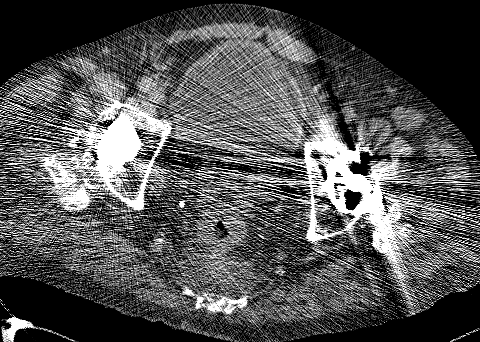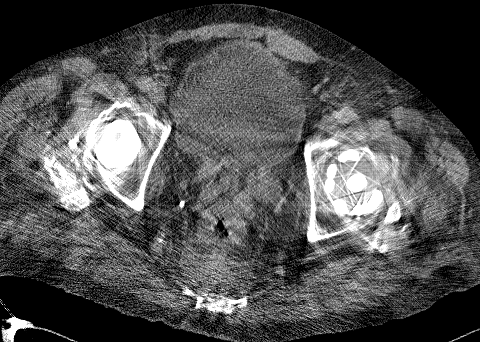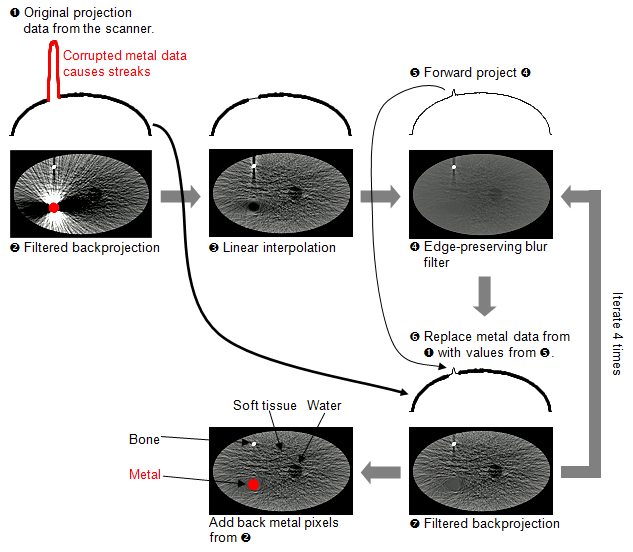Reducing artifacts in computed tomography images
Approximately 20% of the 80 million CT scans performed annually in the US contain metal implants (hip replacements, dental fillings, surgical clips, and pacemaker wires). The metal creates streaks that degrade the image quality, and make the scan difficult to interpret. Several metal artifact reduction techniques have been developed, but none of them are in widespread clinical use, because they are too slow and can introduce new artifacts.
We have developed a new method for metal artifact reduction, called the Metal Deletion Technique (MDT). Our initial experience at Stanford Hospital shows that this technique results in:
- Improved image quality. In a blinded comparison against 3 other methods, MDT was judged to have the best image quality 100% of the time. This is the first metal artifact reduction technique shown to have statistically significantly better image quality than another technique for clinical scans.
- Improved diagnosis. In 18% of patients, the improved image quality actually changed the diagnosis. This includes a case of rectal cancer that was missed with the current technology. These are the first reported cases of a metal artifact reduction algorithm changing the diagnosis.
Here is an example of streak artifacts from the metal in bilateral hip replacements (left). When the metal artifacts are reduced using MDT (right), enlarged lymph nodes around the rectum are seen much more clearly.
 |  |
Metal streak artifacts are caused by the fact that filtered backprojection (FBP) assumes that each detector measurement is equally accurate. In reality, X-ray beams that pass through or near metal implants are highly attenuated and have a much larger error. MDT discards the inaccurate metal data, and only uses high quality data to reconstruct the non-metal portions of the image. The metal data are iteratively replaced with forward projected values. In the diagram below, metal pixels and projection data are shown in red. The original projection data are plotted with a thick line, and revised projection data are plotted with a thin line.

MDT is available now, and it works with DICOM files from any CT scanner. Simply upload DICOM files, and the metal artifacts are automatically reduced.
References
Papers
- Boas FE and Fleischmann D (2012). "Computed tomography artifacts: Causes and reduction techniques." Imaging in Medicine. 4(2): 229-40. [ Article ]
- Abelson JA, Murphy JD, Wiegner EA, Abelson D, Sandman DN, Boas FE, Hristov D, Fleischmann D, Daly ME, Chang DT, Loo BW, Hara W, Le QT. (2012) "Evaluation of a metal artifact reduction technique in tonsillar cancer delineation." Practical Radiation Oncology. 2(1):27-34.
- Boas FE and Fleischmann D. (2011) "Evaluation of two iterative techniques for reducing metal artifacts in computed tomography." Radiology. 259(3): 894-902. [ Article ]
Talks and abstracts
- Boas FE, Bammer R, Fleischmann D. (2012) "Optimized CT Metal Artifact Reduction Using the Metal Deletion Technique (MDT)." Presented at RSNA, Chicago, 2012-11-26. [ Abstract | Slides ]
- Boas FE. (2011) "Iterative techniques for metal artifact reduction." Presented at the International Society for Computed Tomography meeting, San Francisco, 2011-06-13. [ Slides (PDF) ]
- Boas FE and Fleischmann D. (2010) "Evaluation of the metal deletion technique (MDT): A new method for reducing metal streak artifacts in computed tomography scans." Presented at RSNA, Chicago, 2010-11-29. [ Abstract | Video | Slides (PDF) ]
- Golden C, Mazin SR, Boas FE, Tye G, Ghanouni P, Gold G, Sofilos M, Pelc NJ. "A comparison of four algorithms for metal artifact reduction in CT imaging." Proc. SPIE. 7961: 79612Y. [ Abstract ]
Patent applications
- Boas FE. (2012) "Iterative reduction of artifacts in computed tomography images using forward projection and an edge-preserving blur filter." U.S. Patent 8233586. [ View ]
- Boas FE. (2008) "Method and apparatus for reducing artifacts in computed tomography images." U.S. Patent Application 2008/0273651 (abandoned). [ View ]
Related links:
High dynamic range CT scans
Virtual angiography (aka "Google Maps" for IR)
Ed Boas' home page |
Stanford radiology |
CT metal artifact reduction




